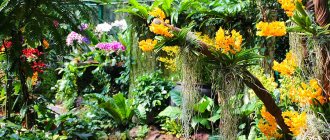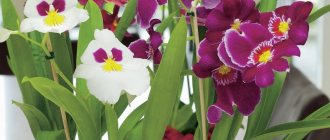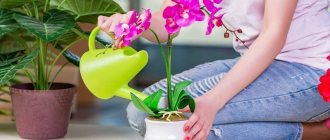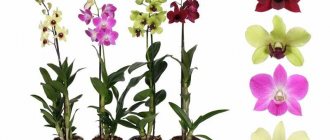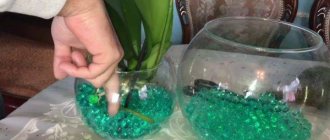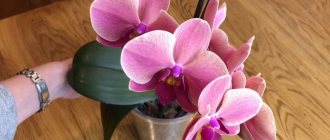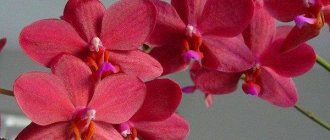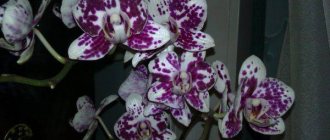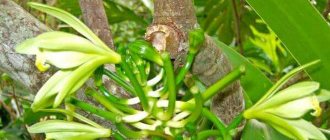Features of care
Illumination
This plant loves bright light, but it should be diffused. It is recommended to place such an orchid on the window sills located in the eastern or western part of the room. If the brassia is placed on a south window, it will need some shading. It can only be placed in the northern part of the room in the summer, since in the cold season it will not have enough light, and therefore it will not bloom. Also in winter, the plant needs additional lighting, because it needs at least 10 hours of daylight.
Temperature
The flower feels best at a temperature of 23–25 degrees. But at the same time, even at ordinary room temperature, it grows and blooms well. It can even be grown in a fairly cool room (15 degrees). To stimulate flowering, brassia needs a difference in day and night temperatures, and the difference between them should be approximately 5–6 degrees. Experts also advise that during the ripening of new bulbs (the beginning of their rounding), reduce the temperature during the day to 17 or 18 degrees, which also helps stimulate flowering.
It is best to move the plant to the balcony in the warm season (from May to September). There he will definitely have enough light, and this will also provide the necessary temperature fluctuations.
Humidity
In the wild, this flower grows in tropical rainforests. Therefore, in order for a plant to feel good in indoor conditions, it needs very high air humidity (the higher, the better). Low humidity in winter can greatly harm the plant. During the autumn-winter period, you need to place the brass as far as possible from the heating pipes. It is also recommended to spray the plant as often as possible, and a humidifier can also help.
How to water
In the warm season, it is recommended to water the plant by lowering the flower pot into a bucket filled with water (hold for 20 to 30 minutes). When the pot is pulled out, you need to wait until the excess liquid drains. In winter, water less often, but at the same time make sure that the pseudobulbs do not wrinkle.
Experienced flower growers recommend systematically checking whether flower stalks have formed. After they are discovered, you must not water the brassia for 7 days. The soil in the pot should dry out almost completely. If you continue regular watering, new bulbs will begin to grow instead of flower stalks.
Earth mixture
For planting, a special soil mixture for orchids is used. You can make it yourself by mixing sphagnum moss, pine bark and high-moor peat. It is also recommended to add pieces of charcoal and add more moss.
Features of transplantation
Brassia does not need regular transplants. This procedure should be carried out only when necessary. So, the plant is replanted if it no longer fits in the flower pot, and the bulbs hang over the edge. During transplantation, it should be taken into account that the bulbs grow only from a certain side. Therefore, it is necessary to leave more free space on the desired side. It is recommended to plant the flower deeper. There should be some free space left on top of the pot. The fact is that young bulbs form slightly higher than the old ones, and you will need to add more soil.
Top dressing
It is necessary to fertilize the soil once every 4 weeks in the spring and summer. For this purpose, use fertilizer for orchids and follow the instructions included with it. Fertilizing is carried out along with watering or while spraying the leaves. In winter, fertilizing is not carried out, especially if the room temperature is low. The flower must be provided with a short period of rest.
How to propagate
If the bush has grown too much, then it is carefully divided. It is taken into account that each division must have at least 3 pseudobulbs, which must be mature.
Pests and diseases
Spider mites may take up residence. To remove it, you need to give the flower a warm shower (water temperature is about 45 degrees).
Root rot may appear if there is too much water in the soil, and the room is also quite cool. The foliage becomes yellow and withers. Then it dies, and the flower itself dies.
General information
Orchid
The inflorescences of Brassia have a rather individual feature. The calyxes of the flowers are elongated and have a sunny color with a greenish tint. This species is popularly called “spider orchid”. Pseudobulbs have one or more linear-lanceolate leaves at the top.
The branching of Brassia is sympodial, which means that after the end of its development, the pseudobulb dies, and a new one appears in its place. The flower has a creeping shoot, a little close to the soil, it is called a rhizome, and so in Brassia it is smaller than average, and the pseudobulbs grow on it in a bunch.
An orchid produces up to 15 inflorescences. The transitional shade is chocolate color with light green dots and, conversely, a light green shade with chocolate spots.
to contents
Planting brassia, choosing a pot and substrate
Vanda orchid
Transplanting brassia has a negative effect on the general condition of the plant, so it is better not to disturb the orchid unnecessarily. The signal for transplantation is provided by tuberidia that crawl out of the flower container or that the substrate is too compacted.
The most suitable time for planting orchids is spring, when young shoots have already appeared and formed their own root system at least 5–8 cm long, but all work must be done before budding begins. During transplantation, they are engaged in both propagation of the bush and sanitary inspection of the roots, followed by cutting off damaged, dead and rotten areas.
A plastic or ceramic flower container is suitable; it is not necessary to plant the plant in a transparent pot. The substrate for growing Brassia is prepared taking into account the requirements of good air permeability and looseness; in a compacted soil mixture, the orchid develops poorly, the roots suffer from a lack of oxygen and gradually die.
Suitable ingredients for the substrate include pine bark, sphagnum moss, peat and some pieces of charcoal; a layer of expanded clay drainage is required at the bottom. Considering that the orchid grows pseudobulbs in one direction, it is advisable to place it in the pot not in the center, but away from the wall towards which the growth of tuberidia will be directed.
Growing
Brassia does not like frequent transplants. You can determine that the time for transshipment has come by the strong compaction of the substrate. If the pseudobulbs hang over the sides of the pot and the roots protrude from the substrate, this is a clear sign that the pot has become too small for the plant. It is best to carry out the transplantation procedure in the spring, when the young shoots have grown a few centimeters and begin to produce their own roots, but it is extremely undesirable during flowering. Transshipment will help to identify the condition of the root system and carry out the rehabilitation of diseased and rotten shoots. This time is also most preferable for dividing the bush for propagation purposes.
The pot for Brassia must be plastic or ceramic with a mandatory drainage layer. It is not recommended to deepen the roots too much.
Diseases and pests
- Spider mites are a dangerous pest for orchids. It feeds on plant sap. White dots first appear on the leaves below, and then the leaves become brownish-gray. A thin cobweb entwines an orchid. A hot shower and spraying with acaricides will help; fitoverm is the most harmless. 3 – 4 treatments are required with an interval of 5 – 6 days.
- Scale insects and mealyworms attack the leaf axils, especially in hot weather. Spraying the orchid with karbofos, fozalon and other chemicals will save it. Repeated treatment is carried out after a week. Treatment is carried out for a month.
- Slugs - disinfection of the pot and pre-treatment of the substrate can save you from them.
- Root rot is a dangerous disease for Brassia. The reason is waterlogging of the air and soil. Orchids are especially susceptible to such diseases in winter. Its leaves wither and turn yellow. You can lose a flower. Spraying and watering with foundationazole will help. For prevention, repeat the procedure 3 times every 10 days. Reduce watering, adjust humidity and temperature.
Cambria orchid
Reproduction and transplantation of Brassia
If desired, you can propagate a branching adult plant. The most favorable time for this is spring, when intensive development of the orchid resumes after the winter break. Using sterile scissors or a scalpel, the bush is divided into the required number of parts, leaving more than three ripe bulbs on each. The cut areas are sprinkled with ash or ground cinnamon. Then the parts are placed in different pots in a substrate prepared in advance.
Four days later, the pot with the young plant is immersed in warm water for half an hour for watering. You should cut off the first shoots and sprinkle the cuts with ash.
You should not replant Brassia unless necessary, because this procedure injures the root system and can lead to a lack of flowering.
The reason for replanting is usually the fact that the plant has outgrown its flower pot, and the pseudobulbs have begun to hang over the edge.
Be sure to keep in mind that Brassia pseudobulbs grow only on one side of the plant. When replanting, leave a certain amount of free space in the pot for this, planting the flower closer to the opposite side. Another feature of the growth of young bulbs of this orchid is that they appear higher than the previous ones, so plant the flower at a sufficient depth, leaving space at the top so that over time you can add substrate to the pot.
Before transplanting, take care to prepare the substrate. You can use a store-bought one or make it yourself. When purchasing, choose a substrate for epiphytic orchids. When making the mixture yourself, use sphagnum peat moss as a base. It should be at least 80% of the total volume of the substrate.
Substrate for orchids
Add fine fractions:
- conifer bark;
- activated and charcoal;
- chopped fern roots.
Do not compact the substrate in the pot. It should allow air to pass through well, ensuring sufficient ventilation of the root system. Having prepared the mixture in this way, you need to sterilize it by boiling it for 10 minutes in a water bath.
If the root system is damaged during transplantation, it is carefully cleaned of the old substrate and soaked in water at a temperature of +30°C. After this, check the roots again and carefully trim off the damaged areas. After undergoing the transplant procedure, Brassia requires a more attentive attitude towards herself within two weeks.
It will also be interesting: The orchid has faded - what to do next with the arrow and how to trim it?
Step-by-step instruction
Landing
Brassia is a special flower, the bulbs grow only on one side, arranged in a ladder, the new bulb grows a “step” higher than the previous one. Therefore, Brassia has its own planting rules:
- free spacious, fairly high pot;
- during planting, the flower is lightly pressed against the edge of the pot;
- it is necessary to free up sufficient space for the growth of new bulbs;
- plant deeper, taking into account the addition of substrate, to form a hill.
Home care
It is proper watering that allows our American guest to bloom. In summer it should be watered abundantly; irrigation can be added. In winter and autumn, watering and spraying are reduced, and a moderate dry regime should take effect here.
The water, which must be settled or passed through a filter, is warm enough, slightly above room temperature. We water Brassia using the immersion method. We lower the pot into a bucket of water for 15 - 20 minutes, then let the excess water drain into the pan, but drain the water so as not to soak the roots. Dry the soil between waterings.
ATTENTION: As soon as flower stalks appear, stop watering for several days, this will help the formation of new bulbs. If small wrinkles appear on the bulbs, stop watering for 5-7 days.
If small wrinkles appear on the bulbs, stop watering for 5-7 days.
How to transplant?
An orchid is usually replanted in the spring, so it better adapts to new conditions. If the substrate has become very compacted, the bulbs have grown so much that they do not fit into the old pot, they have to hang over it - it’s time to replant
It is important not to bury the plant in the ground. Usually transplantation is combined with orchid propagation
When transplanting, follow the recommendations:
- It is safer to use the transfer method: we move the entire earthen ball into another pot.
- We clean the roots from the old soil using treated tools to avoid infection.
- Pre-soak the root in warm water, remove diseased, damaged roots.
- You need to move the orchid away from the center of the pot, leaving more space.
- The substrate is poured to 75% of the pot's fullness, taking into account its further addition.
The transplant is stressful for Brassia. Its adaptation lasts 1-2 weeks, watch the flower!
Priming:
- good drainage for air circulation (pebbles, crushed stone, foam);
- charcoal;
- moss - sphagnum;
- riding moss (as an addition);
- medium sized pieces of pine bark.
The prepared substrate can be disinfected using a water bath for 10 minutes.
Pots can be made of plastic or clay without enamel; the surface of the pot should be slightly rough; it is easier for the roots to settle on such a surface. Flower growers advise keeping Brassia in hanging baskets or flowerpots.
Watch a video about how to properly transplant a Brassia orchid:
How to propagate?
A young orchid can be bought in a store, but it is easy to propagate at home.
- Brassia reproduces vegetatively by division.
- The procedure is carried out in the spring, when it is actively developing.
- An adult orchid is cut closer to the main, maternal bulb.
- We clean the root from old, affected shoots.
- We treat the cut areas with charcoal.
- Each renewed bush should have 2 - 3 bulbs.
- We plant each part in the prepared substrate.
- Water after 4-5 days by immersion in warm water.
- We carefully cut off the first shoots and treat the cut areas with charcoal.
Varieties description and photo
The genus of this orchid is quite diverse, there are more than fifty of them. We will describe the most famous and unpretentious species.
Warty
The most common and unpretentious type of this orchid. It blooms at any time of the year, grows up to 50 cm. The flowers are pale, greenish-yellow, the petals are narrow, gracefully and harmoniously combined into a single variegated flower arrangement.
Watch a video about the features of the Warty Brassia:
https://youtube.com/watch?v=Hsx76HAst6Q
Spotted
Gives the aroma of vanilla, the flowers are bright yellow and quite large. Purple splashes add a special charm to this orchid. The petals are narrowed, pointed, like skewers.
Tailed
The flowers are soft yellow, curved. They look like little funny gnomes - fireflies, sitting down to rest and lowering their long thin legs. The aroma is more intense than that of other types of this orchid.
Royal
This is a hybrid. The aroma exudes an unusual one. Blooms thickly and profusely. Flowers look like stars spinning in a dance - their petals are so symmetrically raised. A very sophisticated and sophisticated orchid.
Simmer dream
The flowers are large, up to 15 cm. Similar to magic octopuses - twins. Against the background of the pale yellow color of the flower, brown spots, symmetrically located on the petals, stand out colorfully. The lip is large, wide, slightly gathered, wavy, adds a festive look and greatly decorates the orchid.
Brassidium
This is also a hybrid. Brassidium blooms thickly, the petals are variegated spiders. It’s as if the lanterns gathered in a garland are about to light up with a festive light. Charming and delicate orchid.
Description and varieties of plants
Rose Eric Taberli: description, cultivation and care
At the base of the rosette there are pear-shaped pseudobulbs; belt-shaped leaves (2 or 3) extend from them. The plates are dense, up to 40 cm in length and about 7 cm in width, glossy, dark green, tapered to the tip. The rosette of leaves is fan-shaped. The bulbs are formed alternately, as one dies, another grows. The stems are creeping, short, the bulbs are located at a small distance.
Attention! Brassia flowers attract parasitic wasps, who mistake the buds for insects and try to lay eggs in them.
Peduncles from 10 to 60 cm, up to 16 buds are formed on each; brassia blooms in spring and in the first half of summer. The petals are long, almost thread-like with contrasting spots, the lip is diamond-shaped. The aroma is reminiscent of a mixture of narcissus and vanilla, sharp. Flowers bloom alternately during daylight hours, flowering lasts about 23 days. There are 43 varieties in total. There are many natural hybrids (grex) formed by cross-pollination with other orchids. Let's highlight a few of the most common varieties.
| Variety | Description |
| Brassia Summer Dream | Flowers are up to 17 cm in diameter, the petals are yellow with brown, symmetrically located spots. The lip is yellow or greenish with a wavy edge, large and wide. Peduncles thin, drooping |
| Tailed | The flowers are about 18 cm in diameter in a very delicate yellow or lemon shade, the petals are long with purple spots. The aroma is rich. The peduncles are long, the tip bends under the weight of the buds. Flowering begins in February and continues until the end of summer |
| Spotted | The flowers are very bright, yellow, no larger, up to 16 cm in diameter. The petals are thin, pointed, slightly longer than 18 cm, and covered with pinkish-purple spots. Lip yellow-cream with brownish-pink large spots |
| Warty | The easiest species to care for, it grows up to half a meter. Peduncles are thin, up to 80 cm in length. Flowers are 8 or 12 cm in diameter, greenish-yellow, white or brownish-beige, the petals are almost thread-like. Blooms from May to the last ten days of July. The petals have chocolate inclusions, and the white lip is dark red and raised (like warts) |
| Brassia Tuscany | The pseudobulbs are oblong, green, the leaves are large and fleshy. Peduncles are from 30 to 60 cm in height, erect, with 8–13 buds formed on each. Flowers up to 10 cm in diameter, yellowish-brown with contrasting, large inclusions |
| Arc-nosed | Immediately after the buds open, the petals are light green yellow, a little later they acquire an orange tint, and the spots are brown. The lip is white or matches the petals, strewn with small cherry splashes |
Such species and hybrids as Baquerara, Miltasia, Royal, Unnoticed and Brassidium deserve attention. One of the brightest and most unusual is the Orange Brassia; its flowers are very rich, yellow-orange, the petals are thin with a purple stripe in the middle. The species blooms from the first half of January to mid-summer, the aroma is quite strong, but unobtrusive, more vanilla.
Brassia orchid care at home
Brassia is quite capricious in care. The plant should be located on the eastern side with little diffused light and constant ventilation without drafts.
The air temperature in summer should be 23 degrees, and at night about 19; such temperature changes are required for the formation of the bulb and peduncle. In winter, the plant should not be exposed to temperature changes; its optimal temperature is about 18 to 22 degrees. In summer, it is possible to move the orchid to a loggia or to fresh air outside, but it is necessary to take into account changes in night temperature.
to contents
Diseases and pests of Brassia
The most common pest found in Brassia is the spider mite. Its appearance is noticeable by the cobwebs on the leaves and flowers. Rinse the orchid in a shower with water temperature of +45°C if you suspect such an infection. Leaf axils can become breeding grounds for scale insects or mealyworms.
Will destroy the pest, regardless of its type, by treating the plant:
- Karbofos.
- Fozalon
- Actellicom.
Repeated treatment is carried out a week later.
Spider mite
The weak point of all orchids is the root system, which is highly susceptible to decay. Pseudobulbs can also develop root rot. The disease is usually provoked by a combination of low temperatures and abundant watering. A transparent plastic pot with bottom holes that should be cleaned periodically will help monitor the condition of the substrate and the quality of drainage.
It will also be interesting: Miltonia Orchid - caring for the plant at home
Protection from diseases and pests
Among harmful insects, the main enemies of Brassia are spider mites. You can get rid of them by showering the flower with water, the temperature of which should not be lower than 45 degrees.
As for brassia diseases, the greatest threat is root rot. The reason for its occurrence is stagnation of moisture in the soil at low indoor air temperatures. The main symptom of root rot is yellowing of the foliage and its subsequent wilting. Subsequently, necrosis of brassia tissue develops, as a result of which the orchid is likely to die. It is important to regularly inspect orchids in order to detect alarming symptoms in time and adjust the watering regime.
Rules for caring for Brassia at home
Caring for your Brassia orchid is easy to do at home. You just need to know a few basic rules, following which even a beginner can grow a beautiful plant at home
Please pay attention to environmental requirements. The place for keeping Brassia can be light or semi-shaded
It is best to place the flowerpot in the west or east indoors, although in the summer the orchid may also be suitable for the northern orientation of the windows. If the windows face south, you should create a shadow on the windowsill for the Orchid representative to prevent direct sunlight. If daylight hours last less than 10 hours, artificial lighting should be provided for the plant.
When caring for Brassia at home, room temperature should be maintained throughout the year - about +23...+25°C. It is also possible to grow orchids at +15°C. At the same time, for flowering it requires a temperature difference of 5 – 6°C.
Air humidity should be about 70 - 80%. If there is not enough moisture, the leaves of the plant begin to wrinkle. To moisturize, you can use a tray with wet expanded clay or spray with soft, boiled water.
Caring for a plant involves watering and feeding with nutrients. The substrate must be constantly moist. Water with soft water. After flowering, during the month-long dormant period, watering should be reduced. Every month, from May to September, fertilizing is carried out with a special fertilizer for orchids. It must contain the correct amounts of potassium, phosphorus and nitrogen.
A very important step in caring for a Brassia orchid is planting it. Planting a plant is necessary at the time of planting its children and the primary pseudobulb in different pots, as well as when transplanting an adult unit into a more spacious pot. Plastic or clay containers with holes made in the bottom are suitable for this, which will prevent liquid stagnation. If the pot is plastic, then it is better to give preference to transparent material.
To plant Brassia at home, you need a special substrate for orchids, which includes:
- Sphagnum moss.
- Conifer bark
- Peat.
- Charcoal.
To protect it from the possible appearance of slugs, before planting, you should rinse the soil with boiling water or dry it at high temperatures in the oven.
The plant must be replanted every spring. When carrying out the procedure, you should remember that you can bring your pet back to life after suffering stress with the help of a warm shower (with water heated to +36°C).
This stage of caring for Brassia at home is shown in the photo:
It is especially important to replant an orchid if its roots do not fit in the flowerpot and hang over the edges. Requires porous drainage, loose, well-permeable soil
It is important to remember that during replanting, the orchid is buried in the substrate so that the young false bulbs, appearing on top of the old ones, can be sprinkled with soil. It is necessary to place it not in the middle of the pot, but closer to the wall - pseudobulbs will not develop on this side.
Brassia breeding is shown in the following video:
A pest such as a spider mite may appear on your pet, and you can get rid of it by taking a warm shower with water heated to +45°C. If the substrate is waterlogged and the air in the room is not warm enough, root rot disease may occur. In this case, the leaves turn yellow, later wither, and the plant dies.
By adhering to these simple rules, it is easy to raise a pet.
Growing Brassia Orchid
Careful care of Brassia at home is not necessary, since the plant is very unpretentious.
Lighting. It is best to place a container with an orchid on a window facing west or east. Brassia likes bright light, but it should be shaded from direct exposure, as it can cause burns.
Temperature. For growing orchids, the most suitable temperature is from twenty to twenty-five degrees, but coolness (not lower than fifteen degrees) does not really matter.
Air humidity. Since the orchid came from humid latitudes, it does not do well in dry air. To do this, it should be constantly sprayed. In the cold season, you should let the orchid rest for a couple of weeks. During this period of time, the temperature must be lowered by three to five degrees and the amount of moisture reduced.
Watering. To water, the container with the orchid should be immersed in a vessel with liquid for fifteen to thirty minutes. Next, you need to check whether all the excess water has drained out. If wrinkles form on the bulbs, then the watering was too abundant and should be stopped for seven days.
For active development and flowering in the cold season, additional color is needed.
You can use the following methods:
- increase the length of the day (slightly more than half a day);
- monthly feeding of the plant with fertilizer;
- temperature difference from seventeen degrees at night to twenty-five degrees during the day.
In the fifth and ninth months, it is recommended to place containers with brass on a balcony without heating. Here, for the flower, all the requirements are met for proper growth and the appearance of buds.
Pests and diseases
The main enemy is the spider mite. If you notice signs of damage, you need to rinse the plant with hot water (forty-five degrees).
False scale insects and hairy louse can be found in the axils of the leaves. To prevent the occurrence of these parasites, brassia should be sprayed with special chemicals. After a week, the plant should be treated again.
Often the roots and bulbs of orchids rot, which is an important problem for the plant. This phenomenon may occur due to excess moisture and low temperature.
The main thing is to prevent water from stagnating in the ground. It is better to choose a transparent pot with special holes that need to be cleaned from time to time.
Brassia orchid propagation
The plant is sometimes purchased, but it is possible to propagate it using an adult. Brassia reproduces asexually, which requires an already branched adult plant.
The spring season is most suitable for propagation, when plant development is more intense.
- It is necessary to divide the bush, cover the cut with coal and plant it in the prepared soil mixture.
- Each small bush should have three mature bulbs.
- It is necessary to water already on the fifth day, immersing the container in a vessel with warm water.
- Young shoots should be removed and the cut should be sprinkled with pieces of coal.
The soil mixture consists of peat moss, pine bark and coal.
The result obtained, prepared at home, must be disinfected with boiling water for ten minutes.
Transfer
If the orchid is cramped in its pot, it needs to be replanted. It is better to replant the orchid by transferring the lump into a ready-made pot. This procedure is done so that the bark in the soil mixture does not rot.
This also helps to avoid damage to the rhizome, since replanting is a rather stressful procedure. New bulbs in most cases grow on one side, so it is better not to replant the plant in the center of the pot. The soil mixture should be poured only two-thirds into the pot.
If the rhizome is injured, you should carefully remove the remaining soil mixture from the roots. First you need to wash the roots in a warm liquid (the temperature should be about thirty degrees Celsius), and then inspect and cut off the damaged parts. After replanting, you should be more careful for one to two weeks.
Diseases and pests
Brassicas are harmed by mealybugs, false scale insects, and spider mites. Depending on the degree of damage, plants infested with parasites are washed with warm soapy water and treated using folk remedies or chemicals - actellik, fozalon, karbofos. Repeated treatment is carried out after 7–14 days to get rid of new larvae that hatched after spraying with pesticides that do not act on the chitinous shell of eggs.
The most common disease in Brassia is that the roots and bases of the pseudobulbs rot, the affected areas spread to the entire tuberidium, and treating the orchid becomes problematic. It is better to prevent root rot; to do this, you need to carefully monitor the abundance of watering, especially at low room temperatures.
Brassia varieties and hybrids
Brassia is an orchid that is a perennial herbaceous plant. Family: Orchidaceae. Homeland - tropical regions of America. Brassia is a very beautiful epiphytic plant. Large, leathery leaves grow from pseudobulbs. False bulbs have an oblong-rounded shape, flattened, tightly placed on the rhizome, with 1 or 3 leaves. Flowers appear on long (up to 50 cm) stems. Blooms from spring to late summer. Its aroma is similar to vanilla.
There are 34 natural species and 33 artificially bred hybrids of orchids of this genus. Take a look at the photo below showing varieties of Brassia. The illustrations clearly demonstrate the variety of colors of the petals of representatives of this plant. As you can see from the photographs, they can be either sunny-greenish tones with brownish inclusions, or brownish with golden-greenish spots.
Among the varieties of Brassia there are:
Brassia filomenoi.
Brassia gireoudian.
Brassia koehlerorum, etc.
Please note that the following video demonstrates the diversity of the Brassia Orchid:
Among the hybrids there are:
Brassioda.
Forgetara.
Miltassia and others.
In indoor floriculture, Brassia verrucosa (B. verrucosa) is usually used. This is due to the fact that it is the easiest to care for, and the plant does not stop blooming almost all year round. The duration of flowering for each flower is about a month.
Brassia: description and characteristics of the orchid
Brassia Orchid: photo
Brassia has external characteristics by which it can be distinguished from other orchids. This includes, first of all, the unusual structure of the flowers, due to which Brassia is often called the “spider orchid”. Their petals are yellow in various shades, as well as numerous voluminous brown spots.
Some species of Brassia are characterized by brown flowers covered with yellow-green spots. Brassia petals are usually elongated, reaching 15 cm in length.
Brassia flowers form inflorescences, each of which has 6-8 flowers; there are specimens with more voluminous inflorescences. Their shape is similar to that of an insect, which is why Brassia received the name “spider orchid.”
One of the advantages of brassia is the pleasant aroma of its flowers, the notes of which evoke associations with the smell of vanilla. However, some gardeners consider this feature to be a disadvantage and do not risk growing such a fragrant plant in a city apartment. However, most indoor plant lovers agree that the smell of Brassia flowers is extremely pleasant. Gardening stores and nurseries often sell hybrid varieties of this orchid, which differ in appearance and aroma. Each gardener can choose a plant to his liking.
Brassia leaves have an elongated lanceolate shape and a rich green color. As a rule, they form a kind of fan around the stem of the plant.
Other advantages of Brassia include its docile nature - when grown indoors, it does not require special care. In addition, these undemanding orchids bloom year-round. Beginning gardeners should pay attention to Brassia Verrucosa, which has earned the title of the easiest variety to care for. Other varieties of this crop also do not require special efforts and special skills and knowledge for their successful cultivation.
Caring for Brassia warty at home
Brassia as a houseplant does not require complex special care at home. This is one of the most unpretentious orchids, which will not be difficult to cope with. You just need to follow a few simple rules, and the plant will delight the owner with long-lasting flowering and lush foliage, filling the house with the aroma of vanilla and narcissus.
Lighting
Brassia tolerates bright light well, provided it is diffused. Direct sunlight can cause burns on delicate leaves and flowers. Therefore, it is preferable to place it on the window sills of those windows that are oriented to the east or west. This way, the orchid will receive enough ultraviolet light in the morning and evening hours and will not be exposed to the midday heat.
During the winter months, lack of sufficient natural light can cause suppression of flower stalks. The duration of daylight for proper plant development and full flowering should be at least 10 hours. Otherwise, additional light sources may be required.
Temperature and humidity
Regarding the temperature regime, this orchid is quite unpretentious. The optimal temperature in a home greenhouse is the range of +23-25°C. But ordinary room temperature is quite acceptable for this flower. In such conditions, the plant will grow well and bloom regularly. Even a microclimate that is quite cool for other varieties of orchids with an air temperature of +15°C will not bring any harm to Brassia.
Stimulation of flowering is created by regular differences between day and night temperatures.
To achieve the desired effect, the difference should be between 4 and 6°C. Another effective method used to obtain lush flowering is to reduce the daytime temperature to 17°C at the stage of rounding of young bulbs.
From May to September, it is recommended to move the plant to the balcony, providing it with protection from direct sunlight. Natural daily temperature fluctuations and a sufficient amount of ultraviolet radiation will ensure regular and effective flowering.
This orchid grows in tropical forests. In order for Brassia to feel like it is in its natural habitat, it is necessary to achieve a sufficiently high level of humidity in the room. Using a humidifier and regular fine spraying of the orchid can help with this. You can create an acceptable microclimate by using pallets filled with wet expanded clay or sand. You can also put sphagnum peat moss soaked in water in them.
When using moistening methods, it is necessary to ensure that the Brassia root system does not submerge in water. Its “aerial” roots are prone to rotting.
Watering and fertilizing
Watering from May to October occurs by lowering the flower pot into a bucket filled with water. The recommended duration of this procedure is up to half an hour. After removing the pot, you need to wait until excess water drains through its drainage. Winter watering is done much less frequently. The plant is kept in a relatively dry state, preventing the pseudobulbs from shrinking.
An important nuance in watering Brassia is monitoring the formation of new flower stalks. If a young sprout is detected, you should stop watering for a week, allowing the substrate to dry almost completely. This method helps prevent the transformation of young peduncles into pseudobulbs.
It is recommended to apply fertilizers to the soil no more than once every four weeks.
This should be done exclusively during the warm period, using a special nitrogenous fertilizer “For orchids”. It must be diluted to the concentration specified in the instructions with water for watering or spraying. It is recommended to alternate root and foliar feeding.
In winter, the application of fertilizers should be avoided, since at low temperatures plant metabolism is significantly reduced, which leads to the accumulation of minerals in the substrate and provokes the appearance of parasites or rotting of the root system.
Preparing for winter
Dry air during the heating season is harmful to orchids. The flower is placed away from radiators and heaters. The upcoming dormant period should be accompanied by a decrease in the frequency of watering and the exclusion of fertilizers.
It will also be interesting: Cambria Orchid - care and propagation of indoor plants at home
Description of appearance
Exotic Brassia is a perennial orchid, there are about 34 species related to it, the natural environment is the forests of America. Flowers are special both in shape and color. The petals are long, like cobwebs, pale green, sometimes bright lemon or yellow-green. Throughout the flower there are brown or dark burgundy spots - moles.
The leaves are belt-shaped, the edges of the leaves taper towards the apex, resembling the shape of a pointed knife - a lancet; bright green, glossy, dense. The Brassia rosette looks like a fan of leaves. The bulbs grow gradually, replacing one another. The leaves are dense, smooth, rich green.
ATTENTION: The stem of Brassia is short, creeping, the bulbs accumulate, form a bouquet or a ladder, pressing closely against each other. The aroma is special, even harsh, reminiscent of the smell of spring daffodils
Conditions of detention
Lighting
Daylight should last at least 10 hours; if sunlight is not enough, you can use additional lighting - phytolamps. If Brassia doesn’t receive enough light all the time, it simply won’t bloom. Brassia loves diffused, slightly dim light, so it is better to place it on the east or west side, or shade it with a light curtain.
Humidity
Moderate humidity is recommended - 50 - 60%. If the young shoots look sluggish and begin to shrink, it is necessary to humidify the air. Light spraying or moistening the soil will help - the pots are placed on a tray with wet pebbles or expanded clay.
IMPORTANT: Brassia does not tolerate dry air well
Temperature
In summer, during the day the room should warm up to 20-23°C, at night a little lower - 18-19°C. The difference in differences is small, 2 - 3°C, but the difference is required, it affects the growth of the peduncle and the bulb itself.
In winter, the orchid needs rest, so the temperature can be reduced by 2 - 4°C. For the correct formation of flower buds, the orchid is moved to a cool place, without heating, in September and May.
Place
It is better to choose a well-lit place for our modest one, but the orchid cannot stand the bright scorching sun; it is better to place it on the eastern or western side. If this is not possible, then artificially shade the windows with tulle, blinds, or curtains.
Description of the variety and origin of Brassia
Brassia is a flowering perennial plant belonging to the orchid family. This genus of orchids has about 30 species, very similar to each other. Brassia warty is distinguished from other indoor plants by its very unusual flowers, which have a clear resemblance to long-legged spiders. On the surface of the shortened yellow petals there is a scattering of convex brown specks.
Color options
At the same time, there are specimens with exotic flower colors: almost brown rounded petals with bright light green splashes. The Royal Brassia flowers resemble clusters of small stars, while the Summer Dream variety has pale yellow large flowers.
The hybrid varieties turned out to be very beautiful:
- Miltassia (Brassia + Miltonia) with purple flowers;
- Bakerary (Brassia + Miltonia + Odontoglossum + Oncidium) – a bright and variegated orchid;
- Brassidium (Brassia + Oncidium) with flowers that look like small colored spiders.
Main characteristics
The large lower leaf of the Brassia flower, the lip, does not have a connection with the column. Elongated sepals with thin thread-like edges reach a length of 15 cm. Usually the inflorescence developing in the leaf axil has 6-8 buds arranged in succession, but there can be twice as many. The peduncle can grow up to 50 cm. The Brassia Orchid in the photo very much resembles a bright tropical insect.
The thick pear-shaped pseudobulbs of this orchid are hidden by two or three strap-shaped leaves arranged in a dark green fan around the base. Closer to the edge, the dense and smooth leaf becomes sharper, resembling a lancet. Having completed its life cycle, the bulb dies, and a young one forms directly above it. Due to the short creeping stem, the bulbs that are closely spaced can form a “ladder” at the base of the flower.
Orchid advantage
The Brassia verrucosa orchid has a number of obvious advantages that speak in its favor when choosing from a store-bought assortment of flowers. It is unpretentious and grows well in a home greenhouse or just on a windowsill. The ability to bloom year-round makes it an original decorative decoration for a living room. Growing such a flower is very simple, and even a gardener without experience can handle this orchid.
It will also be interesting: Orchid Zygopetalum - caring for a houseplant at home
Description
The place of natural distribution of the genus Brassia, which numbers about 30 species of perennial herbaceous plants, is considered to be the tropical regions of the American continent.
The overwhelming majority are epiphytic sympodial (several growth points) orchids of medium size. Not too bright, but extremely expressive flowers with thin long petals and sepals surround a rather large lip. The overall picture is so reminiscent of a schematic representation of an insect that the plant is often called a spider orchid. Only a few species are known in indoor floriculture, but on their basis dozens of hybrid forms and expressive varieties, characterized by great viability and relative unpretentiousness, have been bred. Brassia also easily interbreeds with other varieties of orchids. In this way, grexas (Orchid hybrids) that are very popular among gardeners are Miltassia (Miltonia x Brassia), Baquerara (Miltonia x Odontoglossum x Oncidium x Brassia), Brassidium (Brassia x Oncidium). Many varieties based on their base have proven themselves to be excellent at home. Among the most popular are the picturesque Brassia Toscana and the spectacular Brassia tessa.
Transplanting and propagating phalaenopsis orchids at home
If the container in which the flower grows has become small and the growth of the orchid has slowed down, this means that it is time to replant it.
As a rule, phalaenopsis orchids are replanted no more than once every two years; it should be done very carefully and carefully so as not to damage the aerial roots. When replanting phalaenopsis at home, it is best to cut or break the old container, and place the orchid along with the earthen ball in a new pot, adding fresh substrate
To grow the plant, it is better to use transparent plastic pots in which drainage holes can be made. To remove salts, it is necessary to rinse the soil once a month under running warm water for 15-20 minutes.
Trim the faded arrow 1 cm above the largest bud that has not blossomed: a new peduncle can grow from it.
Propagation of the phalaenopsis orchid is carried out by dividing the adult plant, which is cut into two parts with a knife so that each has its own roots. Sometimes dormant buds of peduncles develop into babies; they are planted after the appearance of their own root system. It is possible to propagate phalaenopsis at home by seeds; in plants grown from seeds, flowering can begin in 2-3 years.
Secrets of success
Brassia is considered to be relatively easy to care for compared to other orchids. She requires bright, diffused lighting.
The temperature is moderate - +23-25°C in summer, +16-18°C in winter. You need to ensure that the difference between daytime and nighttime readings is about 5°C in warm weather, and at least 3°C in cold weather.
A constant flow of fresh air is very important, but drafts, especially cool drafts, are completely unacceptable.
During the growing season, water the plant abundantly, using warm (up to 30°C) settled water, but not too often, allowing the top layer of the substrate to dry out. During the dormant season - extremely moderately, but without leading to the substrate drying out, pseudobulbs shrinking and leaves wrinkling.
It is advisable to maintain air humidity in the range from 50 to 70%. Periodic spraying using a fine sprayer is important in the summer heat and during the heating season. In this case, moisture should not get on the buds so as not to damage their decorative effect.
